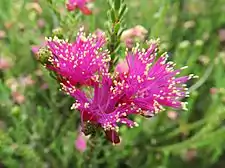Eremaea fimbriata
Eremaea fimbriata is a plant in the myrtle family, Myrtaceae and is endemic to the south-west of Western Australia. It is a small shrub with small leaves and single purple flowers on the ends of the branches. The fruits are woody, urn-shaped with a small opening at the top. Unlike other eremaeas which remain dormant during winter, Eremaea fimbriata begins the new year's growth in July or August.
| Eremaea fimbriata | |
|---|---|
 | |
| Eremaea fimbriata in the Royal Botanic Gardens, Cranbourne | |
| Scientific classification | |
| Kingdom: | Plantae |
| Clade: | Tracheophytes |
| Clade: | Angiosperms |
| Clade: | Eudicots |
| Clade: | Rosids |
| Order: | Myrtales |
| Family: | Myrtaceae |
| Genus: | Eremaea |
| Species: | E. fimbriata |
| Binomial name | |
| Eremaea fimbriata | |
| Synonyms | |
|
Melaleuca curtifolia Craven & R.D.Edwards | |
Description
Eremaea fimbriata is a shrub growing to a height of about 1.0 metre (3 ft). The leaves are narrow egg-shaped, tapering to a point and are 4–8 millimetres (0.2–0.3 in) long, 0.5–4 millimetres (0.020–0.16 in) wide and have one or sometimes 3 veins visible on the lower surface. There are a few long, soft hairs on the upper surface and the lower surface is densely covered with short, fine hairs.[2][3]
The flowers are pink to deep pink and are borne singly on the ends of long branches which grew in the previous year. The flowers are 10–20 millimetres (0.4–0.8 in) across and have are 5 sepals which are densely hairy on the outside surface and have a short tuft of hairs on the top. There 5 petals, 2.8–4.6 millimetres (0.1–0.2 in) long. The stamens are about 8 millimetres (0.3 in) long are arranged in 5 bundles, each containing 13 to 18 stamens. Flowering occurs from July to September and is followed by fruits which are woody capsules. The capsules are 8.6–11 millimetres (0.3–0.4 in) long, smooth and urn-shaped to almost spherical with a small opening.[2][3]
Taxonomy and naming
Eremaea fimbriata was first formally described in 1839 by John Lindley in A Sketch of the Vegetation of the Swan River Colony.[1][4] The specific epithet (fimbriata) is from the Latin fimbriatus meaning "fringed".[5]
Distribution and habitat
Eremaea fimbriata occurs in near-coastal areas of the Irwin and Darling districts in the Geraldton Sandplains, Jarrah Forest and Swan Coastal Plain biogeographic regions.[6] It grows in sandy soils, often with lateritic gravel.
Conservation
Eremaea fimbriata is classified as "not threatened" by the Western Australian Government Department of Parks and Wildlife.[6]
References
- "Eremaea fimbriata". APNI. Retrieved 12 August 2015.
- Hnatiuk, Roger J. (1998). "A revision of the genus Eremaea (Myrtaceae)". Nuytsia. 9 (2): 160–162. Retrieved 2 November 2020.
- Corrick, Margaret G.; Fuhrer, Bruce A. (2009). Wildflowers of southern Western Australia (3rd ed.). Kenthurst, N.S.W.: Rosenberg Publishing Pty. Ltd. p. 121. ISBN 9781877058844. Retrieved 12 August 2015.
- Lindley, John (1839). A Sketch of the Vegetation of the Swan River Colony. London: James Ridgway. p. ix. Retrieved 12 August 2015.
- Brown, Roland Wilbur (1956). The Composition of Scientific Words. Washington, D.C.: Smithsonian Institution Press. p. 157.
- "Eremaea fimbriata". FloraBase. Western Australian Government Department of Parks and Wildlife.